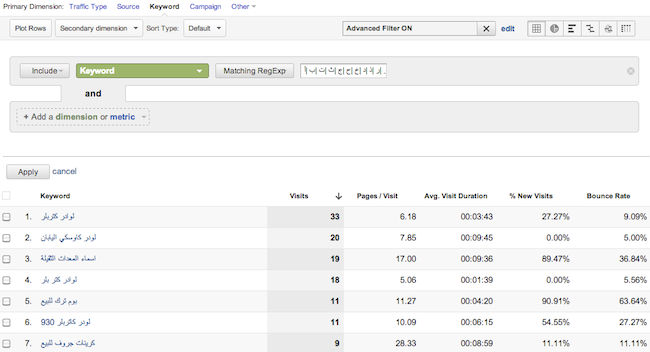Mastering SEO for Arabic Keywords: A Strategic Imperative for E-Commerce Success in the GCC
In today’s hyper-competitive e-commerce ecosystem, brands competing in the UAE and GCC markets are increasingly discovering a critical blind spot in their growth strategies: ineffective SEO for Arabic keywords. Despite Arabic being the dominant language among native populations, most digital strategies still prioritize English-centric search performance, resulting in missed opportunities, reduced visibility, and lower conversion rates. At Brick2Bytes, we help e-commerce leaders close this gap with data-driven frameworks for Arabic-first optimization across Google, Amazon.ae, Noon, and beyond.
In this guide, we’ll walk through the strategic and tactical approaches required to master Arabic SEO, enhance discoverability, and unlock untapped audiences in the region.
The Regional SEO Gap: Why Arabic Optimization Matters Now
While the GCC is surging with digital-first retail adoption, Arabic remains drastically underrepresented in search-optimized content. According to a 2023 SEMrush study, only 7% of e-commerce content is Arabic-first, even though over 80% of the UAE’s national population are native Arabic speakers. This disparity creates a ripe environment for businesses that act early with Arabic SEO-centric campaigns.
Additionally, 56% of users in the UAE start their buying journey on search engines, with another 25% turning straight to marketplaces like Amazon.ae and Noon. Marketplaces in particular handle Arabic-language queries separately from English queries. Lacking Arabic-optimized listings and metadata thus severely limits your exposure and performance.
To learn more about navigating these platforms, explore our full Noon marketplace management services and Amazon account management solutions.
Introducing the Brick2Bytes Framework for Arabic SEO Optimization
Our approach to SEO for Arabic keywords is not just about translation—it’s about cultural relevancy, technical precision, and iterative testing. Here’s how we structure the strategy:
1. Market-Language Research & Intent Mapping
- Use tools like SEMrush (Arabic data), Ubersuggest Arabia, or Ahrefs MENA settings to uncover high-intent Arabic search terms by category and location.
- Map differences in dialects between GCC countries—what works in Saudi Arabia may underperform in the UAE.
- Incorporate hybrid searches and transliterations (e.g., “موبايل سامسونج s22” or “makeup كيت”).

2. Arabic-First Content Development
Skipping over proper content localization is one of the most costly mistakes we see brands make. Machine translations often misinterpret meaning, tone, or context.
- Work with native speakers to transcreate—not just translate—product titles, bullets, meta tags, and CTAs.
- Leverage seasonally relevant and cultural terms like “رمضان عروض” (Ramadan offers) or “الأكثر مبيعاً” (best seller).
This step also enhances on-marketplace click-throughs. Culturally aligned copy speeds up decision-making and builds trust faster with Arabic-speaking audiences.
3. On-Marketplace Optimization for Amazon.ae & Noon
Marketplace algorithms, especially Amazon’s A9, treat Arabic keywords independently. That means your listings must be optimized for these terms:
- Strategically include Arabic phrases in titles, backend keywords, descriptions, and bullet points.
- Use A+ Content in Arabic where available to improve time on page and conversion rates.
- On Noon, continuously A/B test Arabic-centric versus bilingual listings and monitor CTR/sales lift.
For a deeper dive on leveraging analytics in Noon, check out our Noon Seller Lab guide.
Comparison: Arabic vs. Bilingual Product Listings on Amazon.ae
| Feature | Arabic Only Product Listings | Bilingual (Arabic & English) Product Listings |
|---|---|---|
| Target Audience | Primarily targets Arabic-speaking customers in the UAE. | Targets both Arabic and English-speaking customers, including a large expatriate population in the UAE. |
| Market Reach | Limited to users who search and prefer to browse in Arabic. May miss a significant portion of the market, especially those who use English as their primary online language. | Broadens market reach significantly, tapping into both local Arabic speakers and the diverse English-speaking expatriate community. |
| Searchability (SEO) | Keywords must be carefully researched and optimized in Arabic to rank for relevant search terms. May miss out on English search queries. | Requires robust keyword research and optimization in both Arabic and English, including transliterations, to ensure products appear in various search results. |
| Customer Engagement | Connects deeply with Arabic-speaking customers, fostering trust and loyalty by speaking to them in their native language and understanding cultural nuances. | Enhances customer engagement by providing information in the preferred language of a wider audience. Can build trust with both Arabic and English speakers. |
| Conversion Rates | Potentially high conversion rates among Arabic-speaking customers who prefer to purchase in their native language (studies show a significant percentage prefer this). However, may alienate English speakers. | Generally leads to higher overall conversion rates by addressing the language preferences of a broader customer base. Poor translations can lead to low conversion rates. |
| Trust & Credibility | Demonstrates cultural sensitivity and a commitment to the local market, building strong trust with Arabic-speaking buyers. | Builds credibility and professionalism with a wider audience. Well-translated listings convey attention to detail and a commitment to serving all customers. |
| Cultural Nuances | Allows for precise cultural adaptation in messaging, imagery, and product descriptions, avoiding potential cultural faux pas. | Requires careful consideration of cultural sensitivities in both languages to ensure appropriate messaging for a diverse audience. |
| Effort & Cost | Requires investment in high-quality Arabic translation, including native speakers who understand regional dialects and market nuances. | Requires a greater investment in professional translation and localization for both languages, potentially including A+ Content in both. |
| Amazon’s Policies | While Amazon.ae supports Arabic, listings primarily in Arabic may not fully leverage the platform’s multi-lingual capabilities for broader visibility. | Amazon encourages localization. Bilingual listings align well with Amazon’s global selling strategies and tools like “Build International Listings” (though this primarily automates translations, professional human translation is recommended for quality). |
| Competitive Advantage | Can differentiate you from competitors who only list in English, appealing strongly to a segment of the market. | Offers a strong competitive advantage by reaching a larger, more diverse customer base and providing a superior shopping experience to both language groups. |
4. Off-Marketplace Arabic Content Funnel
A strong Arabic content strategy boosts organic traffic and brand trust—well before buyers reach your product page. Here’s what to include:
- Arabic-language blog posts covering category tips (e.g., how to choose a power bank in Arabic tech blogs).
- Arabic FAQ sections, buyer’s guides, and even product demo videos with Arabic subtitles.
- Link back to your product listings or D2C store to move users down the funnel.
This approach also enhances domain authority for Arabic search queries—critical for long-tail traffic.
5. Continuous Iteration & Localization Updates
Just as you iterate on paid campaigns and English SEO, Arabic keyword strategies demand regular updates. Here’s how:
- Track rankings using SEMrush’s Arabic dashboard and Google Search Console’s language filtering.
- Use Amazon Brand Analytics to monitor Click Share and Search Frequency Rank for Arabic-origin search terms.
- Refresh your copy with keywords tied to local events like Ramadan, GITEX, and back-to-school shopping.
Top Pitfalls to Avoid in Arabic SEO Strategy
Even well-intentioned campaigns can fail if the wrong tactics are used. Here are the mistakes we help clients avoid:
- Literal Translation Over Transcreation: Don’t rely on Google Translate to speak to your buyer—it will misrepresent search intent and cultural nuances.
- Neglecting Regional Dialects: A phrase-indexed for UAE consumers may not resonate in KSA, Oman, or Kuwait. Always geo-target your keyword research.
- Keyword Stuffing in Arabic: Overuse of keywords in Arabic script breaks natural readability—and may get penalized in Google or even Amazon’s algorithm.
For further regional context, our guide to UAE’s key marketplace players can shed light on platform-specific buyer behavior.
Key Performance Metrics That Define Success
When executed correctly, SEO for Arabic keywords can deliver measurable growth. Here’s how to track the ROI:
- Arabic Organic Rankings: Identify your top 10 transactional Arabic queries and monitor monthly movement via Ahrefs and Search Console.
- On-Page Conversions: Compare CTR, add-to-cart, and conversion rates on listings with and without Arabic optimization.
- ASIN Discoverability: Monitor changes in Amazon Brand Analytics, tracking Search Frequency Rank and Click Share on Arabic queries.
Not sure where to start? Our free consultation includes a complimentary Arabic SEO audit and market opportunity assessment.
Arabic-First SEO: A Strategic Growth Lever in the GCC
In an era where the digital shelf is crowded and consumer attention is fragmented, brands that go beyond basic translation and implement Arabic-optimized SEO gain sustainable leverage. Whether you’re launching on Amazon.ae, expanding on Noon, or scaling your D2C UAE store, optimizing Arabic-language content is no longer optional—it’s a growth imperative.
Localizing your content and search strategy doesn’t just increase visibility; it deepens relevance, compresses the consideration cycle, and builds long-term brand loyalty among Arabic-speaking customers.
Schedule a free consultation with a Brick2Bytes expert today and receive a complimentary analysis of your current setup.








